The lake is generally oriented north to south and is in an oval shape with an arm extending out to the west. Lakota is small; it takes only about 15 minutes to paddle the north – south length of the lake, even at a leisurely pace. The setting is beautiful: some rolling hills, more trees than usual and in great variety including evergreens, and grasses and bushes along the shore line.

A unique quality to this lake is the extent of aquatic grass and other water plants. While the aquatic grass is extensive along the shore, it is also easy to kayak over the top of it. The water is exceptionally clear, and through breaks in the aquatic grass a person can see bottom details at four feet or more. I especially liked moving over the aquatic grass up the western arm of the lake. The water was pretty deep: I often could not touch bottom with a double bladed kayak paddle. Traveling through the grass seemed to me like a polar setting where a kayaker might seek out leads in the ice – clear pathways through the ice. It was much like that with the grasses in Lake Lakota. In deep water, the grass would extend like the vegetation of a jungle. There were clearings where I could look deep in the water. Paddling on top of the grass was easy, as long as I kept the rudder up.
I can not imagine wind waves gathering on Lake Lakota, at least while the grass is thick on large parts of the water.
As always, I found the shore line the most interesting part of the lake. I saw a muskrat swimming and scampering along the edge of the water, several large turtles, a number of big frogs sitting on the vegetation even in deep water while helping keep the insect population down, ducks and geese up in the western arm of the lake, and a lot of small fish flitting through the clear spots within the “Sargasso Sea” of Lake Lakota.
On a Wednesday morning, the park was deserted, and there were two boats with fishermen moving slowly around the middle of the lake. This would be a good spot to bring a family or group of people who wanted to have a day in a beautiful setting – a little swimming, a little kayaking, some sitting around in the shade, a picnic lunch. Lake Lakota would be a very nice spot for beginners in a kayak. For more seasoned paddlers, the scenery and the search for wildlife would have to be the major attractions of this lake. It is right next door to Newton Hills State Park; so, it would be possible to go for a paddle at the lake and then take in a nice hike along the trails in the park.

No comments:
Post a Comment